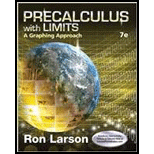
Concept explainers
To find: first five terms of the arithmetic sequence for given first term and common difference. Verify the result graphically.
Answer to Problem 31RE
First five terms of the arithmetic sequence are
Explanation of Solution
Given information:
An sequence is given with first term
Concept used:
An arithmetic sequence of n terms, has the form
That is
Common difference can be defined by d .
nth term of the arithmetic sequence has the form
Where
Calculation:
Now, consider the first term and the common difference.
First five terms of the sequence can be found as shown:
Hence, the first five terms of the sequence are
Now, the expression for nth term can be found as
Use the table feature of graphing utility to find the first 5 terms of sequence by using following steps:
Press MODE key, select Seq in the fourth line and hit Enter

Press

Set the table by pressing TBLSET and then press TABLE,

Hence, the result is verified.
Chapter 8 Solutions
Precalculus with Limits: A Graphing Approach
- The radius of a sphere decreases at a rate of 3 m/s. Find the rate at which the surface area decreases when the radius is 8 m. Answer exactly or round to 2 decimal places. The surface area decreases at a rate of m²/sarrow_forwardi need help pleasearrow_forward(#1) Consider the solid bounded below by z = x² and above by z = 4-y². If we were to project this solid down onto the xy-plane, you should be able to use algebra to determine the 2D region R in the xy-plane for the purposes of integration. Which ONE of these limite of integration would correctly describe R? (a) y: x24x: -22 - (b) y: 22 x: 04-y² (c) y: -√√4-x2. →√√4x²x: −2 → 2 (d) z: 24-y² y: -2 → 2 (e) None of the abovearrow_forward
- X MindTap - Cenxxxx Answered: tat "X A 26308049 X 10 EKU-- SP 25: X E DNA Sequenc X b/ui/evo/index.html?elSBN=9780357038406&id=339416021&snapshotid=877369& GE MINDTAP , Limits, and the Derivative 40. Answer 5 4-5 t-10 5 f(x) = 2x - 4 if x ≤0 if x 0 10 ++ -4-3-2-1 f(x) = MacBook Pro Search or type URL 5 1234 x² +1 if x = 0 if x = 0 +arrow_forwardMindTap - Cemy X Answered: tat x A 26308049 × 10 EKU--SP 25:11 × E DNA Sequence x H. pylori index.html?elSBN=9780357038406&id=339416021&snapshotid=877369& NDTAP and the Derivative 41. 42. Answer 12 Ay 5 + -10-5 5 10 -5- f(x) = x +5 if x ≤ 0 -x²+5 if x > 0 to -5 5. 5 f(x) = |x − 1| MacBook Pro AAarrow_forwardMind Tap - Cenxxx Answered: tat X A 26308049 × 10 EKU-- SP 25: X E DNA Sequence x H. pylor vo/index.html?elSBN=9780357038406&id=339416021&snapshotld=877369& MINDTAP its, and the Derivative 44. Answer 5 X -10-5 5 10 -5. f(x) = 2 + x +5 if x 0 3 4 f(x) = x² - 1 x+1 if x = -1 MacBook Pro G Search or type URL if x = -1 + AA aarrow_forward
- Calculus lll May I please have an explanation of the multivariable chain rule in the example given? Thank youarrow_forwardMind Tap - Cenxxx Answered: tat X A 26308049 X 10 EKU-- SP 25:1 x E DNA Sequence x H. pyl /nb/ui/evo/index.html?elSBN 9780357038406&id=339416021&snapshotid=877369& ⭑ SAGE MINDTAP a ons, Limits, and the Derivative 吃 AA In Exercises 45, 46, 47, 48, 49, 50, 51, 52, 53, 54, 55, and 56, find the values of x for which each function is continuous. 45. f(x) = 2x²+x-1 Answer▾ 46. f(x) = x³- 2x²+x-1 47. f(x) 2 = x²+1 Answer 48. f(x) = 49. f(x) = Answer 50. f(x) = 51. f(x) = I 2x²+1 2 2x - 1 x+1 x-1 2x + 1 x²+x-2 Answer↓ 52. f(x)= = x-1 x2+2x-3 53. $ % MacBook Proarrow_forward37. lim f (x) and lim f (x), where x+0+ x 0 Answer -> 38. lim f (x) and lim f (x), where +0x x―0M 2x if x 0arrow_forward
 Calculus: Early TranscendentalsCalculusISBN:9781285741550Author:James StewartPublisher:Cengage Learning
Calculus: Early TranscendentalsCalculusISBN:9781285741550Author:James StewartPublisher:Cengage Learning Thomas' Calculus (14th Edition)CalculusISBN:9780134438986Author:Joel R. Hass, Christopher E. Heil, Maurice D. WeirPublisher:PEARSON
Thomas' Calculus (14th Edition)CalculusISBN:9780134438986Author:Joel R. Hass, Christopher E. Heil, Maurice D. WeirPublisher:PEARSON Calculus: Early Transcendentals (3rd Edition)CalculusISBN:9780134763644Author:William L. Briggs, Lyle Cochran, Bernard Gillett, Eric SchulzPublisher:PEARSON
Calculus: Early Transcendentals (3rd Edition)CalculusISBN:9780134763644Author:William L. Briggs, Lyle Cochran, Bernard Gillett, Eric SchulzPublisher:PEARSON Calculus: Early TranscendentalsCalculusISBN:9781319050740Author:Jon Rogawski, Colin Adams, Robert FranzosaPublisher:W. H. Freeman
Calculus: Early TranscendentalsCalculusISBN:9781319050740Author:Jon Rogawski, Colin Adams, Robert FranzosaPublisher:W. H. Freeman
 Calculus: Early Transcendental FunctionsCalculusISBN:9781337552516Author:Ron Larson, Bruce H. EdwardsPublisher:Cengage Learning
Calculus: Early Transcendental FunctionsCalculusISBN:9781337552516Author:Ron Larson, Bruce H. EdwardsPublisher:Cengage Learning





